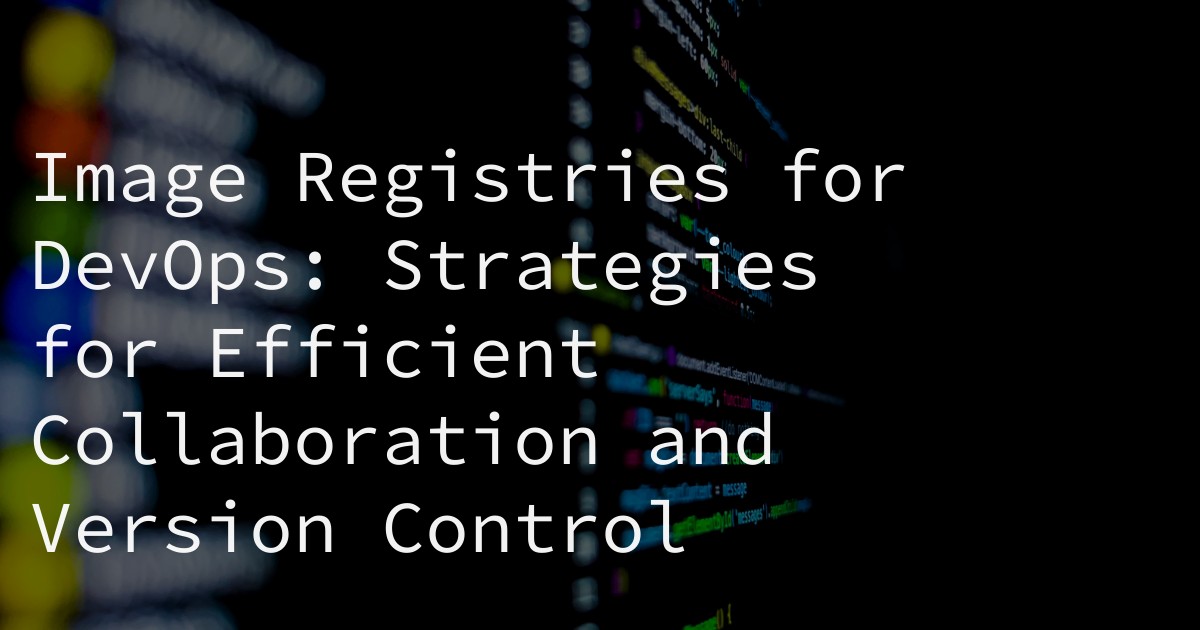
10 Nov Image Registries for DevOps: Strategies for Efficient Collaboration and Version Control
Image registries play a crucial role in the world of DevOps, providing a central location for storing and managing images used in the development and deployment process. In order to optimize collaboration and version control in DevOps, it is important to have efficient strategies in place for managing image registries. In this article, we will explore the various strategies that can be utilized to ensure efficient collaboration and version control with image registries in a DevOps environment.
Understanding Image Registries for DevOps
Before diving into the strategies for optimizing collaboration and version control, it is important to have a clear understanding of what image registries are and their purpose in a DevOps environment. Image registries are repositories that store and manage images used in the development and deployment process. These images can include application code, configurations, and dependencies. The key features and benefits of using image registries in DevOps include:
- Centralized storage and management of images
- Efficient distribution and sharing of images among team members
- Version control and tracking of changes to images
- Integration with CI/CD pipelines and infrastructure as code
Implementing Effective Strategies for Image Registries
1. Version Control and Tagging
Version control and tagging are essential for efficient collaboration and version control in DevOps. By implementing version control, changes to images can be tracked and managed, allowing for easy rollback to previous versions if needed. Tagging also plays a crucial role in version control, as it allows for easy identification and organization of images. Best practices for version control and tagging with image registries include:
- Using semantic versioning for consistent and meaningful version numbers
- Implementing a tagging strategy for different stages of the development process (e.g. development, testing, production)
- Utilizing descriptive tags to easily identify the purpose of an image
2. Automated Build and Deployment
Automation is key in DevOps, and this also applies to image registry management. By utilizing build triggers, images can be automatically built and deployed when changes are made to the code. This not only saves time and effort, but also ensures consistency and reduces the risk of human error. Integration with CI/CD pipelines allows for seamless automation of the build and deployment process.
ALSO READ
3. Access Control and Permissions
In order to ensure secure image registry management, it is important to have proper access control and permissions in place. Role-based access control (RBAC) can be implemented to restrict access to images based on user roles and responsibilities. Additionally, the use of secrets and encrypted registries can further enhance security by protecting sensitive information.
4. Collaboration and Sharing
Collaboration and sharing of images among team members is essential for efficient DevOps processes. Image repositories and channels can be utilized to facilitate this collaboration, allowing team members to easily access and share images. Pull requests and approvals can also be implemented to ensure controlled and secure image sharing.
ALSO READ
5. Monitoring and Auditing
Monitoring and auditing of image usage and changes is important for compliance and security purposes. Image scanning can be utilized to detect and mitigate vulnerabilities in images. Integration with logging and tracing tools also allows for visibility and troubleshooting in case of any issues.
6. Disaster Recovery and Backup
Disaster recovery and backup plans are crucial for image registries, as they ensure that images can be recovered and restored in case of any disasters. Strategies for implementing disaster recovery and backup plans include replication and backup tools, which can be used to store images in multiple locations for redundancy.
Conclusion
In conclusion, efficient collaboration and version control in DevOps can be achieved by implementing effective strategies for image registries. By utilizing version control and tagging, automation, access control and permissions, collaboration and sharing, monitoring and auditing, and disaster recovery and backup, image registries can be managed in a secure and efficient manner. As DevOps continues to evolve, it is important to stay updated on the latest advancements and trends in image registry management in order to optimize collaboration and version control in the development and deployment process.
RELATED ARTICLES:



Sorry, the comment form is closed at this time.